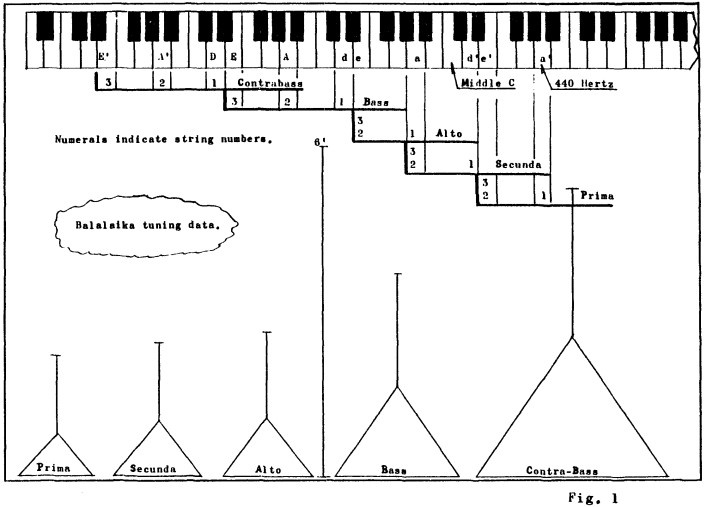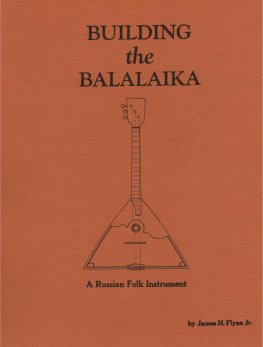James Flinn - Building the Balalaika
Here you can read online James Flinn - Building the Balalaika full text of the book (entire story) in english for free. Download pdf and epub, get meaning, cover and reviews about this ebook. year: 1984, genre: Art. Description of the work, (preface) as well as reviews are available. Best literature library LitArk.com created for fans of good reading and offers a wide selection of genres:
Romance novel
Science fiction
Adventure
Detective
Science
History
Home and family
Prose
Art
Politics
Computer
Non-fiction
Religion
Business
Children
Humor
Choose a favorite category and find really read worthwhile books. Enjoy immersion in the world of imagination, feel the emotions of the characters or learn something new for yourself, make an fascinating discovery.
- Book:Building the Balalaika
- Author:
- Genre:
- Year:1984
- ISBN:0-9613258-0-1
- Rating:3 / 5
- Favourites:Add to favourites
- Your mark:
- 60
- 1
- 2
- 3
- 4
- 5
Building the Balalaika: summary, description and annotation
We offer to read an annotation, description, summary or preface (depends on what the author of the book "Building the Balalaika" wrote himself). If you haven't found the necessary information about the book — write in the comments, we will try to find it.
Building the Balalaika — read online for free the complete book (whole text) full work
Below is the text of the book, divided by pages. System saving the place of the last page read, allows you to conveniently read the book "Building the Balalaika" online for free, without having to search again every time where you left off. Put a bookmark, and you can go to the page where you finished reading at any time.
Font size:
Interval:
Bookmark:
* PUBLISHER *
J. H. FLYNN, Jr.
1704 Drewlaine Drive
Vienna, Virginia, U.S.A. 22180
Copyright @by James H. Flynn Jr.
All rights reserved. No part of this hook may be reproduced in any form without the approval in writing from the author.
First Edition February 1984
Library of Congress Catalog Card Number 84-90311
Printed in the United States of America
All rights reserved by Author.
By Special Arrangement with the author, this PDF version was made available on a limited basis to BDAA members and to PennBO Alumni.
October 2004: With the permission of the author, this PDF version is available as a free download on the website of the Guild of American Luthiers: www.luth.org
PDF scanned by Riccardo Heald.

Acknowlegements
To my wife Mary... Thanks for everything.
It was fun loading the VW bus with Engelmann spruce in Santa Fe and the pungent Port Orford cedar in Oregon.... just to make more musical instruments! To our son Handy who did Russian translations for me when he was tired and weary... spasibo! And we cannot forget Balalaika and Domra Association's Hall of Famer Gregory "Grisha" Titoff for evaluating some of my early instruments and giving me useful comments for perfecting them. We enjoyed the many hours spent with him.
Introduction
Sitting here on the campus of the University of California at Berkeley in the summer of 1983 I am many leagues away from the Soviet Union, the native land of the balalaika. Nevertheless, beneath the tall pines and palms I can hear the ringing sounds of balalaikas and domras as members of the Balalaika and Domra Association of America (BDAA) strum their instruments in practice sessions at their fifth annual convention. The BDAA is a multi-ethnic association organized to perpetuate music written for the balalaika and domra and related instruments; to disseminate information pertaining to the musical and cultural heritage of Eastern European traditions; and to provide a forum for the exchange of ideas and developments concerning these instruments and their musical possibilities.
After much exposure to the balalaika and its music and chatting with some of the most talented players in the West, I feel that I should record some of the color and texture of these contacts. My objective, as an amateur luthier, is one of searching for and recording data pertinent to the building of the balalaika. I shall await another time to look at the domra. I was hopeful of obtaining a profile of what a true balalaika should look like as well as recording some of the personal preferences musicians may have in its design. With so many instruments available to me, as well as the opportunity to discuss their features with their proud owners, I believe that I was able to meet my goals.
Most players could recognize a "master" instrument... almost all knew what it took to make an instrument of high quality. I found instruments of superb craftmanship made by both Soviet and American luthiers. I was most pleasantly surprised to find that there are many balalaika makers in the United States and Canada. An even greater discovery was to find so many folks wanting to make their own instruments but lacking data from which to do so.
My hopes in preparing this publication are that it will provide those interested in the balalaika with some of the fundamental construction techniques as well as a description of the balalaika family with related dimensions. Above all, I would like to record this data in hopes of preserving the design of the instruments as the early Russian makers intended.
While I have no talent as a musician, I do have a keen attraction to the entrancing tonal quality of the balalaika. Working with wood and collecting a large variety of it has been a life-long hobby of mine, but my interest in musical instruments started after I retired from my profession as an operations research analyst. Living in Virginia, the Appalachian Mountain dulcimer was the natural instrument to gravitate toward. This truly American folk instrument still keeps my interests high but what more appropriate instrument to study next.... the balalaika, the official folk instrument of the Soviet Union. Why?

The Balalaika
There are many contemporary descriptions of the balalaika. I thought that it would be fitting to search out the official Soviet definition. The description is as follows:
"The balalaika: A two or three-stringed instrument with a triangular or oval shaped body, a relatively long neck with a head tilted back slightly. The overall length of the instrument is 600-700mm. The body of oval-shaped balalaikas is chiselled out; that of triangular ones is made of individual wooden slats. The top is flat, with resonator boles cut into it, often in a star-shaped pattern. There are five fret marks on the neck. The strings are gut; one end is held behind (on top of) the body with a peg; the other connected to a wooden key in the head. The basic tuning is a "forth" (if there are three strings, the second and third are tuned in unison).
There is also a "forth-fifth" tuning, called "discordant", and the "guitar" tuning using a major and minor "third".
Sound is produced by strumming all strings with the fingertips of the right hand, as well as plucking individual strings. The balalaika is a comparatively young instrument. The first mention of it in written sources goes back to 1715 (i. I. Golikov, "Supplements to the Works of Peter the Great," 1792, p. 242). It is possible that the instrument arose as a derivation or deviation from the domra, and, having gained a wide distribution, it quickly supplanted a number of other instruments, including the domra.
Numerous cheap prints and folk illustrations attest to the popularity of the balalaika in country and city musical life. The application of the balalaika in the musical life of the people was diverse: song and dances were performed on it; it accompanied solo and ensemble singing; it was introduced into composition of various instrumental groups. In the 1880*s with the leadership of V. V. Andreyev, the folk balalaika was perfected; on its foundation were created a number of orchestral instruments with chromatic scales - piccolo, soprano (later disused), prima, secunda, alto, bass, and contrabass.
The first performance of a "balalaika club" took place in Petersburg (Leningrad) in 1888, after which balalaika (and after 1896 balalaika-domra) orchestras began to form with surprising speed all over Russia. The success of the balalaika in large part lay in its low cost and ease with which it could be mastered.
Orchestras of Russian folk musical instruments have become particularly widespread during the Soviet period. Folk songs and dances, compositions of classical composers, both foreign and Soviet, all fall within their repertoire".
The tuning data on the balalaika is depicted in Fig. 1 and is related to the lower portion of the piano keyboard. Fig. 1 also scales out the five instruments and compares their size with a six-foot measure. The parts of the balalaika are identified in Fig. 2.


This publication is limited to the general construction techniques useful in building a prima balalaika. Dimensional data for the complete balalaika family are listed in Table I which can be found in the appendix. One has only to determine the size of the instrument to be constructed and then apply the same building procedures to the scaled-up model. The basic profiles of the balalaika, which are shown in Fig. 3, remain essentially the same. One exception is that the bass and contrabass instruments do not have fingerguards of the type used on the smaller instruments. This is because of the manner in which they are strummed. Some of these larger instruments have a protective piece of veneer or plastic glued on the soundboard at critical locations where the soundboard may be damaged by scratches. The two large instruments have a collapsible foot installed in a cut off portion of the left corner of the body. The foot rests on the floor thus facilitating its playing in an upright position. The dimensions shown in Table I are fairly close to average sized instruments but some minor excursions in size (up or down) can be tolerated to suit individual needs.
Next pageFont size:
Interval:
Bookmark:
Similar books «Building the Balalaika»
Look at similar books to Building the Balalaika. We have selected literature similar in name and meaning in the hope of providing readers with more options to find new, interesting, not yet read works.
Discussion, reviews of the book Building the Balalaika and just readers' own opinions. Leave your comments, write what you think about the work, its meaning or the main characters. Specify what exactly you liked and what you didn't like, and why you think so.








